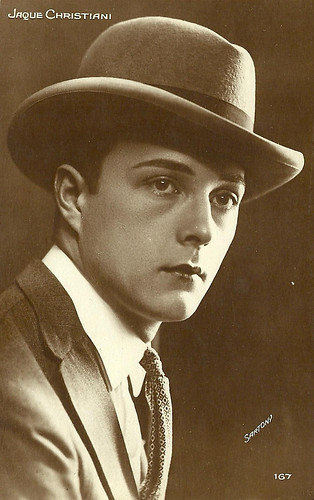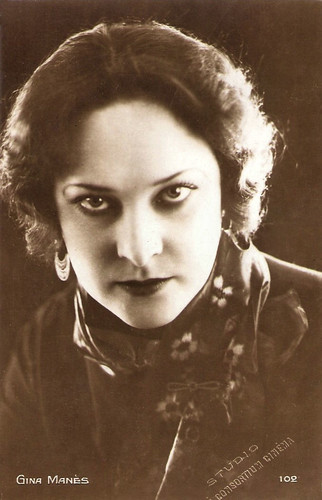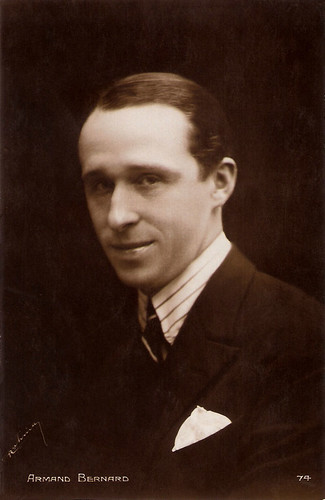
French postcard by Cinémagazine Edition, no. 167. Photo: Sartony. Collection: Didier Hanson.
Jean Epstein
We couldn’t find when or where the actor of this postcard was born. Jaque Christiani is called by IMDb Jacques Christiany and by other sources Jacque-Christiani. According to the always valuable IMDb, he appeared in only nine films and a documentary. But his small oeuvre is quite interesting, and especially his debut film.
In 1923 he probably made his first film appearance with a supporting part in the drama L'auberge rouge/The Red Inn (Jean Epstein, 1923). Poet, film theorist and filmmaker Jean Epstein was one of the most fascinating and important figures in French cinema in the 1920s. His masterpiece would become La chute de la maison Usher (1928), his adaptation of Edgar Allan Poe's 'The Fall of the House of Usher'. Epstein was an early exponent of ‘pure cinema’ through montage.
L'auberge rouge is based on Honoré de Balzac’s novella about two young doctors, who are caught in a storm in 1899 and booked into the Alsace Inn of the title. In the cramped and bustling inn, they share a room with a Dutch diamond merchant. During the rainy night, Prosper (Léon Mathot) steals from the merchant, but when he awakes in the morning he finds the merchant dead and his friend gone. When the stolen property is found on him he is arrested for the crime and executed. 25 years later the innkeeper's daughter (Gina Manès) relates the tale to a traveller, who in turn later tells it at a dinner party. At that party is Frederic Taillefer (Jean-David Évremond), the missing friend and murderer... Director Jean Epstein juxtaposes the two quite different milieus of the Inn and the dinner party and contrasts the characters skilfully.
At IMDb, PaulO reviews: “Epstein slowly builds a mood of tension and dread in this great, rare French silent. Extensive, offbeat use of close-ups (unusual for its day), and less-broad acting than you often see in silent movies, add to the suspense of Balzac's tale of temptation and injustice, told as an after-dinner story that becomes much, much more. The film, just over an hour long, holds up well and leaves a lasting impression. It is rarely seen in the U.S., but the Harvard Film Archive has an excellent print.”
Jaque Christiani’s next film was Nène (Jacques de Baroncelli, 1924) with Sandra Milowanoff in the title role. Christiani again had just a supporting part. He also appeared in the drama Les grands (Henri Fescourt, 1924). A year later he had the lead in On ne badine pas avec l'amour/No Trifling with Love (Tony Lekain, Gaston Ravel, 1925), based on a novel by Alfred de Musset. That same year he also appeared in small parts in Le bossu/The Hunchback (Jean Kemm, 1925) and Madame Sans-Gêne (Léonce Perret, 1925), starring Gloria Swanson.

Gina Manès. French postcard by Cinémagazine Edition, no. 102. Photo: Studio Pathé Consortium Cinéma.
Sinister tower
Then there was an interval of five years in Jaque Christiani’s cinema career, and he returned only after the introduction of sound film. Christiani had the role of the dauphin in Un caprice de la Pompadour/Madame Pompadour (Joë Hamman, Willi Wolff, 1930) featuring Suzy Delair in her film debut. It was an alternative language version of the German production Die Marquise von Pompadour (Willi Wolff, 1931).
In 1932 Christiani had a supporting part in the sound film Monsieur de Pourceaugnac (Tony Lekain, Gaston Ravel, 1932) featuring Armand Bernard.
His last film was the historical film La tour de Nesle/The Tower of Nesle (Gaston Roudès, 1937), based on a novel by Alexandre Dumas père. The title refers to a sinister tower along the Seine River, which was the subject of several legends. D.B. DuMonteil at IMDb writes: “Gaston Roudès - whose name is virtually unknown even by those interested in the French thirties cinema - made the best of his budget which was certainly lower (than Abel Gance’s version of 1953).
The settings are made with care and the cinematography makes good use of black and white to depict the dark corridors and the streets of the sleepy Paris town where the town crier shouts ‘All is quiet! Sleep in peace, Parisians! Everything's all right" when the worst things happen (there are similar scenes in John Ford's Mary of Scotland (1936). Banned in Finland in 1939, probably because of the orgy, which of course would not shock a twelve-year-old today. This is the most famous scene of a forgotten movie, which was outstripped by its remake by Gance - a remake few people know as well.”
Christiani’s final performance in this film was only a small part. We could not find more info on him. Do you know more about Jaque Christiani? Share it. We appreciate it.

Armand Bernard. French postcard by Cinémagazine Edition, no. 74.
Sources: D.B. DuMonteil (IMDb), PaulO (IMDb), Wikipedia and IMDb.
This post was last updated on 26 September 2023.
No comments:
Post a Comment